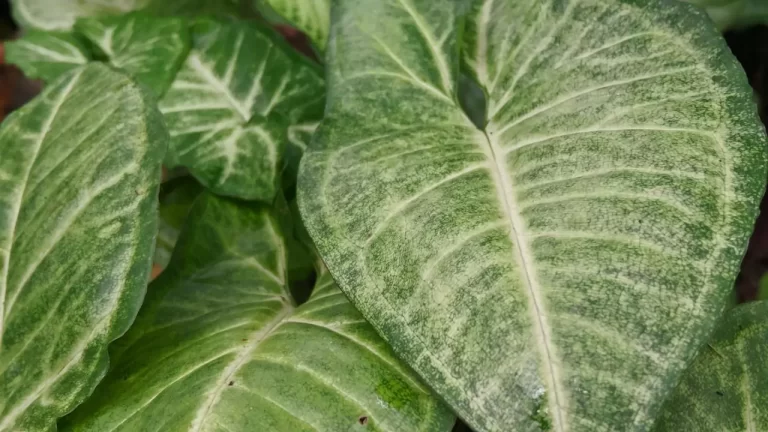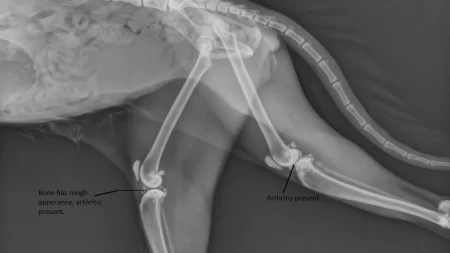Yes, arrowhead plants are toxic to cats. This plant may cause drooling, vomiting, mouth discomfort, and trouble breathing in cats. Arrowhead plants’ insoluble calcium oxalate crystals might hurt your cat’s lips and throat.
This page discusses arrowhead plants, their health dangers, and cat poisoning prevention and treatment.
Overview of Arrowhead Plants
Arrowhead plants (Syngonium podophyllum) are also called African evergreen, trileaf marvel, and goosefoot plant. Their beautiful leaves and simple maintenance make them popular houseplants. Arrowhead plants feature green, pink, or white arrow-shaped leaves. They may be pruned into vines or bushy plants.
Arrowhead plants, like philodendron, pothos, peace lily, and dieffenbachia, are Araceae. Arrowhead plants have needle-like insoluble calcium oxalate crystals that may irritate animal and human skin and mucous membranes.
Health Risks of Arrowhead Plants
Calcium oxalate crystals in arrowhead plant parts can cause mouth and throat discomfort and irritation if your cat eats them. Your cat may drool, vomit, or have trouble breathing. Crystals may injure your cat’s esophagus or stomach, causing bleeding or ulcers.
Arrowhead plant poisoning may induce kidney damage or life-threatening anaphylactic shock. If your cat eats a lot of the plant, these consequences are unusual.
What symptoms should cat owners watch for if their cat has ingested part of an Arrowhead plant?
If you suspect that your cat has ingested part of an arrowhead plant, you should watch for the following symptoms:
- Excessive drooling
- Pawing at the mouth
- Vomiting
- Oral irritation
- Increased respiratory rate
- Difficulty breathing
These symptoms may appear shortly after exposure or within a few hours. If you notice any of these signs, you should take your cat to a veterinarian as soon as possible for diagnosis and treatment.
Treatment Options for Cats
Arrowhead plant toxicity in cats is treated according to symptoms and plant intake. First, rinse your cat’s mouth with lukewarm water to eliminate crystals and ease inflammation. To soothe its tummy, offer your cat milk or yogurt.
Your vet may also prescribe an antihistamine and painkiller to minimize swelling and discomfort. To restore its electrolyte balance, your cat may require intravenous fluids.
If your cat consumes a lot of the plant or has serious symptoms like bleeding or trouble breathing, it may require oxygen treatment, blood transfusion, or surgery.
Prevention Strategies
Keep cats away from arrowhead plants to avoid poisoning. If your cat can reach it, put it on a high shelf or in a hanging basket.
Give your cat grass, catnip, or toys to discourage plant chewing. To stop cats from eating plants, put a bitter apple or lemon juice on them.
Arrowhead plants are also hazardous to other pets and children.
Do Arrowhead plants contain saponins that can be toxic to cats if ingested?
No, arrowhead plants do not contain saponins that can be toxic to cats if ingested. Saponins, another chemical molecule, may induce gastrointestinal distress in animals and humans if taken in excessive amounts. Yucca, soapwort, quinoa, and alfalfa contain saponins.
Arrowhead plants have calcium oxalate crystals instead of saponins. Saponins and calcium oxalate crystals may induce froth, vomiting, and diarrhea in cats.
Are all parts of the Arrowhead plant toxic to cats or just certain parts?
Cats are poisoned by the arrowhead plant’s leaves, stems, roots, and flowers. No portion of the arrowhead plant is safe for cats, regardless of age or color.
Can cats experience symptoms like vomiting or diarrhea from nibbling on Arrowhead plants?
Yes, cats can experience symptoms like vomiting or diarrhea from nibbling on arrowhead plants. Calcium oxalate crystals induce gastrointestinal discomfort and inflammation. Cats may get dehydrated and electrolyte-imbalanced from vomiting and diarrhea.
Therefore, if your cat chews on arrowhead plants, watch its health and seek veterinarian care if it seems distressed or uncomfortable.







